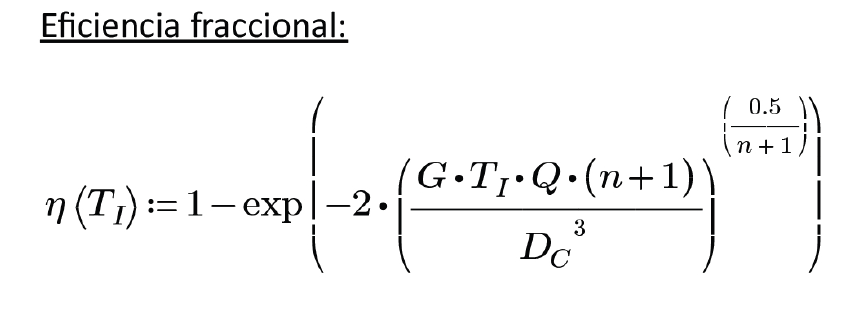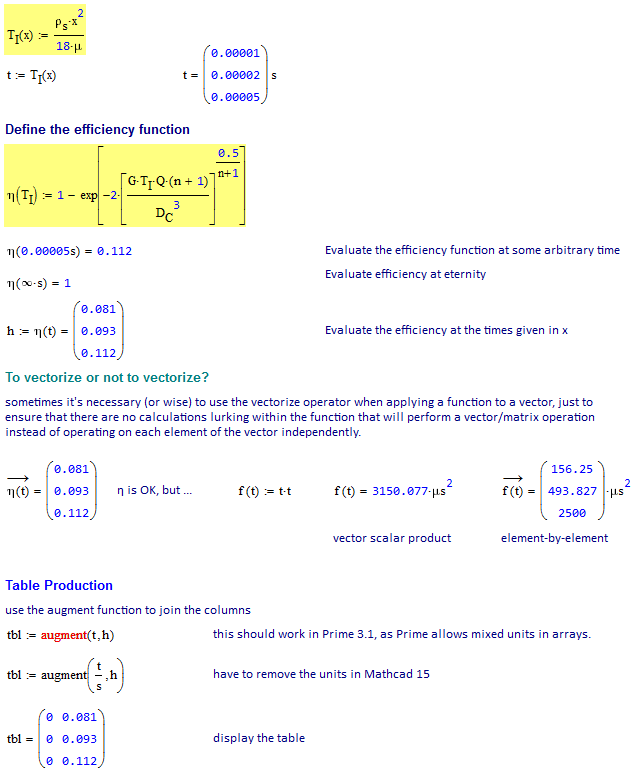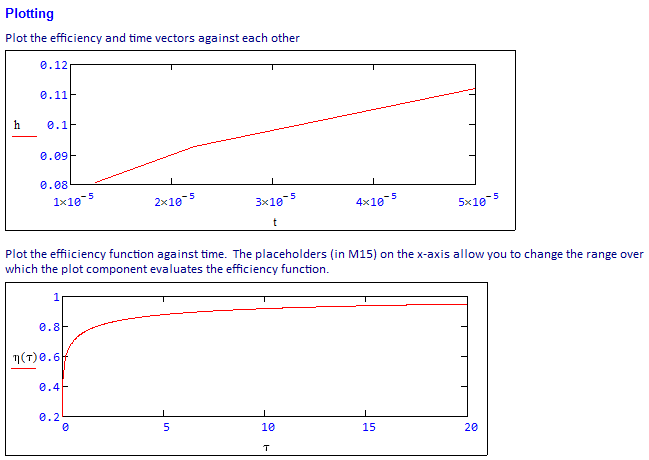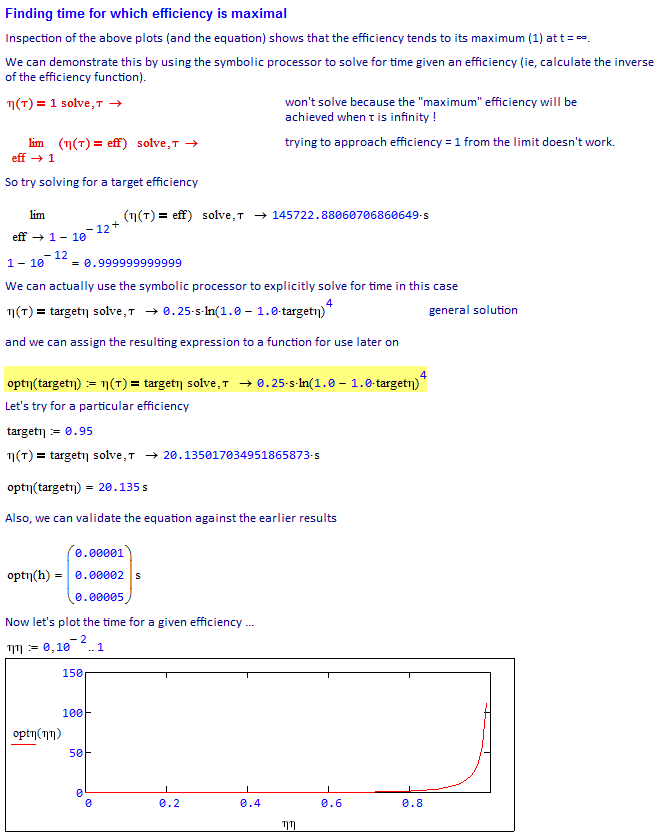Community Tip - Did you get called away in the middle of writing a post? Don't worry you can find your unfinished post later in the Drafts section of your profile page. X
- Subscribe to RSS Feed
- Mark Topic as New
- Mark Topic as Read
- Float this Topic for Current User
- Bookmark
- Subscribe
- Mute
- Printer Friendly Page
multiples variables/inputs
- Mark as New
- Bookmark
- Subscribe
- Mute
- Subscribe to RSS Feed
- Permalink
- Notify Moderator
multiples variables/inputs
Hi, everyone. I´m trying to make a calculation with different inputs values. I looked on the forum but with my little experience I can´t made it yet. May be, my case is more simple than the examples. So I prefer to ask
My input is a diameter particle (x). With that I need to calculate Ti, and with Ti obtain n. Which is an efficiency.
Then, it will be excelent make a table with my inputs "x" on a column, and the efiency "n", on another column. Finally, make a graphic with both.
Also, I take this oportunity to ask. In the future I will need to find the minimal number of "x", which make the efficiency n=1.
The calculation is for the efficiency of a cyclone to separate differents particles depending of their size. So, I want to know in parallel with the other calculation in the same sheet, the smaller particle which I can have a 100% efficiency
I know is probably very simple to do, but I cant.
I attached my problem. All the others variables, are constants.
Thanks to all
- Labels:
-
Other
- Mark as New
- Bookmark
- Subscribe
- Mute
- Subscribe to RSS Feed
- Permalink
- Notify Moderator
you have to use eta(x):=...T(x)... and you may vectorize the call to this function.
If you are using Prime 3.0 or lower its always better to provide the worksheet itself and not just an incomplete pdf. You may also consider to create a simplified version of your sheet showing less variables or dummy factors.
If you are using Prime 3.1 you should provide the worksheet AND a complete pdf, as many of us have not found it worthwhile to upgrade to 3.1 and PTC in its wisdom has decided that P3.1 should not be able to produce files which can be read by P3.0.
If you are using P3.1 you may therefore consider using a most simplified version of your sheet as people using P3.0 (in fact many like me use just the more powerful and convenient Mathcad 15 but have installed P3.0 out of curiosity) would have to retype your sheet and a large sheet clearly would discourage people to do so.
WE
- Mark as New
- Bookmark
- Subscribe
- Mute
- Subscribe to RSS Feed
- Permalink
- Notify Moderator
Emiliano Gu wrote:
Hi, everyone. I´m trying to make a calculation with different inputs values. I looked on the forum but with my little experience I can´t made it yet. May be, my case is more simple than the examples. So I prefer to ask
My input is a diameter particle (x). With that I need to calculate Ti, and with Ti obtain n. Which is an efficiency.
Then, it will be excelent make a table with my inputs "x" on a column, and the efiency "n", on another column. Finally, make a graphic with both.
Also, I take this oportunity to ask. In the future I will need to find the minimal number of "x", which make the efficiency n=1.
The calculation is for the efficiency of a cyclone to separate differents particles depending of their size. So, I want to know in parallel with the other calculation in the same sheet, the smaller particle which I can have a 100% efficiency
I know is probably very simple to do, but I cant.
I attached my problem. All the others variables, are constants.
Thanks to all
Your expression for efficiency:

For efficiency to be 100%, the second term must be zero. Since exp(-N) can never be zero, you cannot have 100% efficiency. You can get close . . .
- Mark as New
- Bookmark
- Subscribe
- Mute
- Subscribe to RSS Feed
- Permalink
- Notify Moderator
> You can get close . . .
Which would mean x-->infinity, looking at the equations and assuming that Emilian means "eta" when he writes "n" here in the forum.
- Mark as New
- Bookmark
- Subscribe
- Mute
- Subscribe to RSS Feed
- Permalink
- Notify Moderator
I don't have Mathcad Prime available at the moment, but the following should readily convert from Mathcad 15 to Prime - you could even use the conversion program to convert the attached worksheet to Prime.
First bit - building a table. Create a vector from your time-dependent function and then simply augment the time value vector [x] to it.

Second Bit - Plotting. Slightly different in Prime, but you should be able to insert a plot and then type in the effeciency and time vectors ...

Third Bit - solving time at which maximum efficiency occurs. Use the symbolic processor to do the inverse calculation, and in this case you're lucky enough that there is an explicit general solution that you can make into a function.

Stuart
- Mark as New
- Bookmark
- Subscribe
- Mute
- Subscribe to RSS Feed
- Permalink
- Notify Moderator
Hi, thank you all for your replies. Finally I made this with your help. I attached the two problems for you to look. It would be very helpfull to know what do you think about this.
For the graphic, I have put manually an interval of numbers because I didn´t know how to put a reference for all a spectrum of values, like 1 to infinit or something like that. Sorry if is very basic my questions but is very new for me





